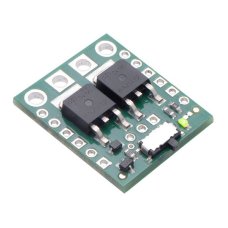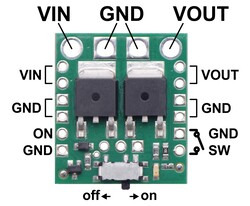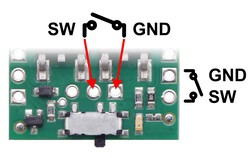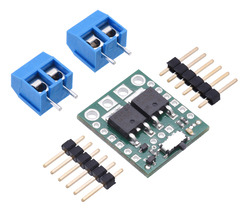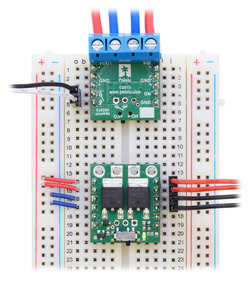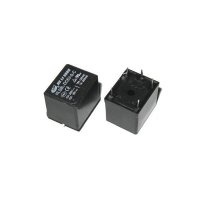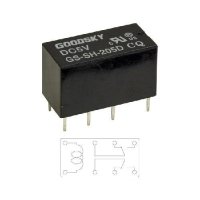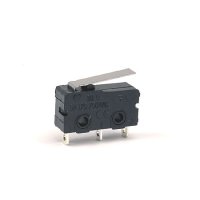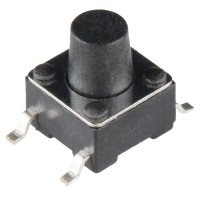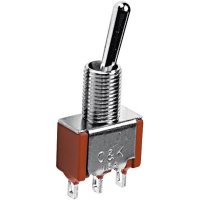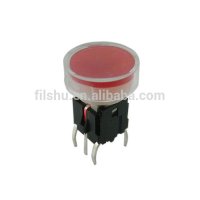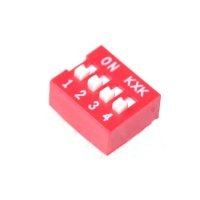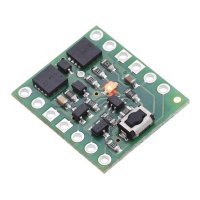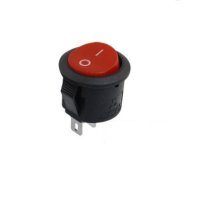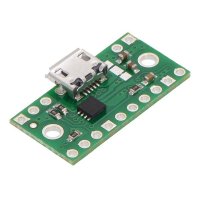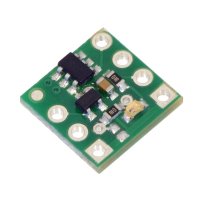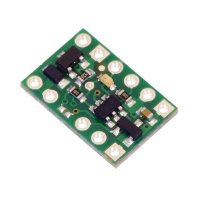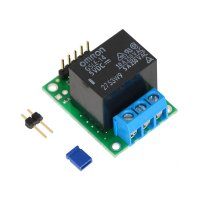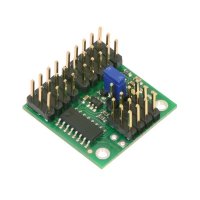Four versions of the MOSFET slide switches are available:
The two Mini MOSFET Slide Switches are smaller, lower-current versions that are useful for applications with tight size constraints or lower power requirements. Also, the the Mini LV is the only one of the four that works below 4.5 V; since it can operate down to 1.8 V, this version can be used with a single lithium cell battery.
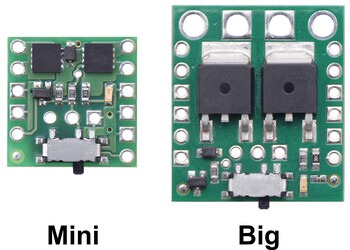 |
The pinout of the Big version is the same as the pinout of the Mini version with several additional redundant connection points for convenience, including main power connections that are compatible with 5 mm terminal blocks.
The primary functional difference between the each of the units arises from the MOSFET used, which sets the operating range and performance of the units:
 LV |
 SV |
 MP |
 HP |
|
|---|---|---|---|---|
| Absolute max voltage: | 20 V | 40 V | ||
| Recommended operating voltage: | 1.8 V to 16 V | 4.5 V to 32 V | ||
| MOSFET combined on resistance (max) | 26 mΩ @ 1.8 V | |||
| 16 mΩ @ 4.5 V | 90 mΩ @ 4.5 V | 40 mΩ @ 4.5 V | 13 mΩ @ 4.5 V | |
| 50 mΩ @ 10 V | 30 mΩ @ 10 V | 8.6 mΩ @ 10 V | ||
| Continuous current at 55°C(1) | 3.0 A | 2.0 A | 4.0 A | 6.0 A |
| Continuous current at 150°C(1) | 6.0 A | 4.3 A | 8.0 A | 16 A |
| Maximum current | 12 A | 7.2 A | 40 A | 90 A |
| Current consumption in on state(2) | ~210 μA/V | ~65 μA/V | ||
| LED color | red | green | ||
| Size | 0.6″ × 0.6″ × 0.1″ | 0.8″ × 1.0″ × 0.16″ | ||
| Weight | 0.6 g | 2.7 g | ||
1 At 12 V with ambient temperature of 22°C in still air.
2 On state current is dominated by indicator LED; current is approximately proportional to input voltage.
Using the MOSFET Slide Switch
|
|
In the most basic application, power can be applied to the VIN and ground pins, with the on-board mini slide switch controlling power on the VOUT pins. To use an alternate SPST switch to control the MOSFETs, set the on-board slide switch to the off position and connect the alternate switch between ground and the switch control terminal, which is accessible both in the center of the board and along the side. The following example shows a larger slide switch soldered directly to the three through-hole pins in the center of the board:
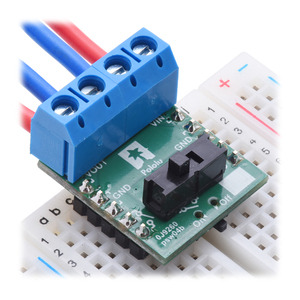 |
|
An example of using a different through-hole slide switch with the Big MOSFET Slide Switch. |
|---|
If the physical switch is in the “off” position, the switch state can also be controlled by a digital signal (e.g. from a microcontroller) via the “ON” control pin. Driving the “ON” pin low (or leaving it disconnected) will leave the switch off; driving the pin beyond approximately 1 V will turn the switch on. The maximum voltage for the “ON” pin is 30 V, independent of the switch voltage (VIN).
Each power node can be accessed through a large hole along the top side of the board or two smaller 0.1″-spaced holes along the sides of the board. For applications drawing more than 5 A, you should either use the large holes or both 0.1″-spaced holes for each power connection.
Included Hardware
|
|
Two 6-pin straight breakaway male headers and two 2-pin 5mm terminal blocks are included with each switch, and you can choose which of these components, if any, to solder to the board. The terminal blocks work with the four large holes, and the header strips allow the switch to be used with solderless breadboards and perforated circuit boards with standard 0.1″ spacing. If you want to use the terminal blocks, we recommend you install them on the side of the board without components, as shown in the above breadboard picture. The terminal blocks will cover one of each of the smaller VIN and VOUT holes, so you should not solder header pins into those holes if you plan on using terminal blocks.
Note that the terminal blocks are only rated for 16 A, so for higher-power applications, thick wires should be soldered directly to the board.
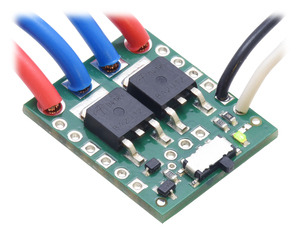 |
Thermal and power dissipation considerations
Because MOSFETs in the on state are effectively resistive, the power heating the board is proportional to the square of the current flowing through it. The comparison table near the top of this page shows typical currents that heat the MOSFETs to 55°C, where the MOSFETs start being noticeably warm but are still generally safe to touch, and currents that heat the MOSFETs to 150°C the absolute limit for the MOSFETs. With adequate cooling, or for brief periods if the MOSFETs are not hot to begin with, currents up to the listed maximums are attainable.
Transient protection
Interrupting large currents can cause voltage spikes (positive on the input side and negative on the output side) that depend on the inductance of the power connections and that can exceed the limits of the device. Appropriate measures to limit the size of these spikes include minimizing lengths of wires, placing capacitors at the power switch to smooth the spikes and absorb some of the energy, placing a schottky diode across the power output to absorb negative spikes, and placing a transient voltage suppressor (TVS) across the power input to absorb positive spikes.
Schematic diagram
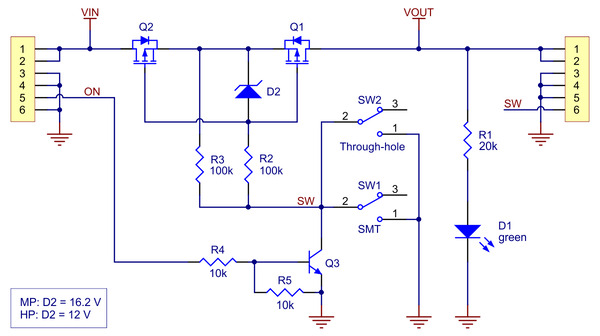 |
|
Schematic diagram of the Big MOSFET Slide Switch with Reverse Voltage Protection. |
|---|
This diagram is also available as a downloadable PDF (647k pdf).
Pololu 2810 / 2811 / 2814 / 2815 MOSFET Slide Switch with Reverse Voltage Protection
- Brand: Pololu
- Product Code: Pololu-MOSFET-Slide-Switch
- Reward Points: 3
- Availability: In Stock
- रo 275.00
-
रo 264.00
- Price in reward points: 275
-
- 25 or more रo 265.00
- 54 or more रo 263.00
- 96 or more रo 254.00
- 250 or more रo 245.00
Available Options
Related Products
Relay - 5V - TLV6
Electromagnetic relay single exchange that allows you to drive loads in low voltage (230V) allowing ..
रo 75.00
Relay Double Pole-5V DC 2A Dual-in-Line
The Dual-in Line relay is designed to offer a completelydust and water-proof package with bifurcated..
रo 35.00
Micro Switch KW12 KW11-3
KW12 kw11-3 Laser Machine Micro Limit Sensor Auto Switch An electrical switch actuated by a very li..
रo 12.00
Push Button Switch SMD - 6mm Square
This is a standard 6mm square SMD momentary button. It has a large button head and good tactil..
रo 3.00
Switch SPDT
A simple changeover switch: C (COM, Common) is connected to L1 or to L2. Note: Product imag..
रo 14.00
Push Button Switch with LED - 6 Pin
6 Pin Tactile switch with LED, Perfect as a tactile reset switch. These buttons are rated ..
रo 119.00
Pololu 2808 / 2809 Mini Pushbutton Power Switch with Reverse Voltage Protection, LV/ SV
The Pololu Pushbutton Power Switches are sophisticated power control alternatives to bulky mechanica..
रo 299.00 रo 312.00
Switch SPDT Round On/Off
Single Pole Double Throw(SPDT) Switch Contact type 3 Pin Terminals Round Button ..
रo 31.00
Pololu 2596 TPS2113A Power Multiplexer Carrier with USB Micro-B Connector
This breakout board for Texas Instruments’s TPS2113A autoswitching power multiplexer allows you to s..
रo 602.00 रo 628.00
Pololu 2801 RC Switch with Digital Output
The Pololu RC switch with Digital Output can be used with standard hobby radio control systems for r..
रo 451.00 रo 470.00
Pololu 2802/2803 RC Switch with Small / Medium Low Side MOSFET
Pololu RC Switch with Small Low-Side MOSFET The Pololu RC switch with Small Low-Side MOSFET can ..
रo 461.00 रo 549.00
Pololu 2805 / 2804 RC Switch with Relay
The RC switch measures the width of incoming RC pulses and compares it to a user-configurable thresh..
रo 831.00 रo 865.00
Pololu 2806 / 2807 4-Channel RC Servo Multiplexer
The Pololu 4-Channel RC Servo Multiplexer can be used with standard hobby radio control systems and ..
रo 754.00 रo 786.00
Tags: Pololu, MOSFET, Slide, Switch, Reverse, Voltage, Protection

